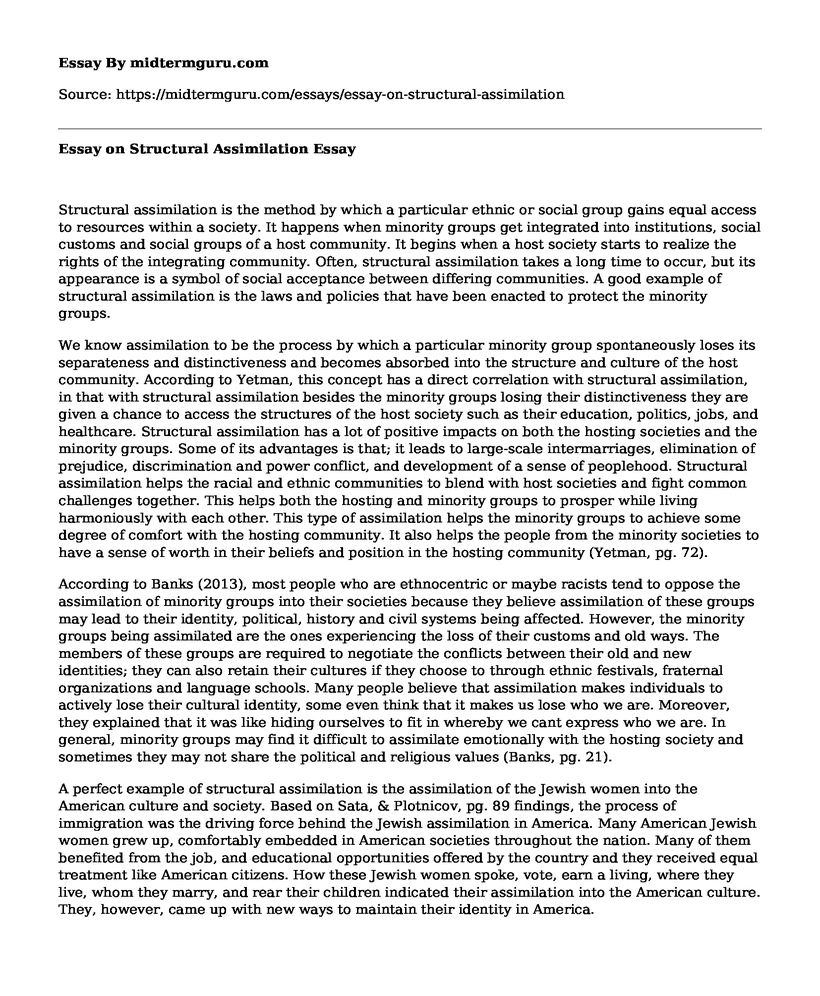Structural assimilation is the method by which a particular ethnic or social group gains equal access to resources within a society. It happens when minority groups get integrated into institutions, social customs and social groups of a host community. It begins when a host society starts to realize the rights of the integrating community. Often, structural assimilation takes a long time to occur, but its appearance is a symbol of social acceptance between differing communities. A good example of structural assimilation is the laws and policies that have been enacted to protect the minority groups.
We know assimilation to be the process by which a particular minority group spontaneously loses its separateness and distinctiveness and becomes absorbed into the structure and culture of the host community. According to Yetman, this concept has a direct correlation with structural assimilation, in that with structural assimilation besides the minority groups losing their distinctiveness they are given a chance to access the structures of the host society such as their education, politics, jobs, and healthcare. Structural assimilation has a lot of positive impacts on both the hosting societies and the minority groups. Some of its advantages is that; it leads to large-scale intermarriages, elimination of prejudice, discrimination and power conflict, and development of a sense of peoplehood. Structural assimilation helps the racial and ethnic communities to blend with host societies and fight common challenges together. This helps both the hosting and minority groups to prosper while living harmoniously with each other. This type of assimilation helps the minority groups to achieve some degree of comfort with the hosting community. It also helps the people from the minority societies to have a sense of worth in their beliefs and position in the hosting community (Yetman, pg. 72).
According to Banks (2013), most people who are ethnocentric or maybe racists tend to oppose the assimilation of minority groups into their societies because they believe assimilation of these groups may lead to their identity, political, history and civil systems being affected. However, the minority groups being assimilated are the ones experiencing the loss of their customs and old ways. The members of these groups are required to negotiate the conflicts between their old and new identities; they can also retain their cultures if they choose to through ethnic festivals, fraternal organizations and language schools. Many people believe that assimilation makes individuals to actively lose their cultural identity, some even think that it makes us lose who we are. Moreover, they explained that it was like hiding ourselves to fit in whereby we cant express who we are. In general, minority groups may find it difficult to assimilate emotionally with the hosting society and sometimes they may not share the political and religious values (Banks, pg. 21).
A perfect example of structural assimilation is the assimilation of the Jewish women into the American culture and society. Based on Sata, & Plotnicov, pg. 89 findings, the process of immigration was the driving force behind the Jewish assimilation in America. Many American Jewish women grew up, comfortably embedded in American societies throughout the nation. Many of them benefited from the job, and educational opportunities offered by the country and they received equal treatment like American citizens. How these Jewish women spoke, vote, earn a living, where they live, whom they marry, and rear their children indicated their assimilation into the American culture. They, however, came up with new ways to maintain their identity in America.
Work Cited
Banks, J. A. (2013.). Assimilation, Cultural and Structural. Encyclopedia of Diversity in Education. doi:10.4135/9781452218533.n58
Sata, I., & Plotnicov, L. (2009). Pittsburgh middle-class Jewish families: Structural assimilation tested through bar and bat Mitzvahs. Contemporary Jewry, 10(1), 33-65. doi:10.1007/bf02965556
Yetman, N. R. (2002). Majority and Minority. The Dynamics of Racial an Ehtnic Relations. Revista espanola de la opinion publica, (27), 458. doi:10.2307/40181733
Cite this page
Essay on Structural Assimilation. (2021, Jun 29). Retrieved from https://midtermguru.com/essays/essay-on-structural-assimilation
If you are the original author of this essay and no longer wish to have it published on the midtermguru.com website, please click below to request its removal:
- Essay Sample on Family Conflicts
- Questions With Answers on Biochemistry: Enzymes
- How to Navigate the Relationship - Essay Sample
- Legalization of Gay Marriages: Breaking Social Barriers in US & UK - Essay Sample
- Quilombola Pottery: Globalization, Economic Anthropology, and Sustainability - Essay Sample
- Role of Mathematics in History - Essay Sample
- Exploring the Physical Geography and Societal Relationships of Papua New Guinea in Oceania - Essay Sample







